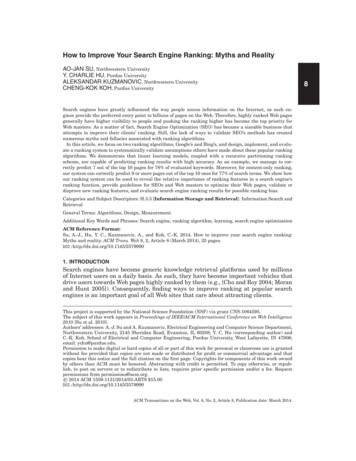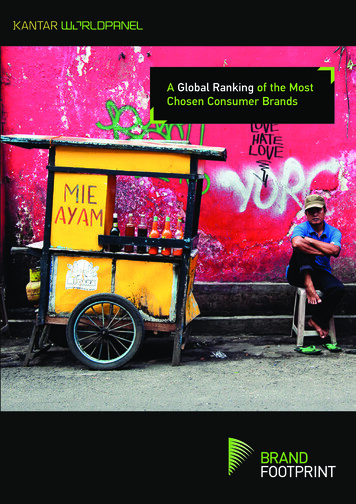
Transcription
A Global Ranking of the MostChosen Consumer Brands1
ForewordContentsBrand Footprint: Inspiring brand growthWhat can we learn from brands winning at the moment of truth?by Sir Martin Sorrell2015 in FMCG041Key highlights from this year's reportBRAND FOOTPRINTReportFundamentals of Brand Growth06How do brands grow? Four key statementsthat offer guidance to today’s marketers5Brand Growth in Practice08This edition – its fourth – paints acomprehensive picture of brand growthover the past year, identifying thestrategic levers that brands can pull inorder to attract more buyers.A powerful component of WPP’s andKantar’s portfolio of reports, BrandFootprint is grounded firmly in the realityof FMCG commerce: real choices by realpeople in real markets across the world.Sir Martin SorrellFounder and CEO, WPPFive strategic levers that have thegreatest impact on brand growthThis year’s Brand Footprint buildson the simple rule that growthis all about penetration, anddemonstrates how brands havegrown against a challengingeconomic backdrop.Channel Hopping18Global brands have to execute shopper plans ina local way10 Brand Footprint Global Ranking Top 50Penetration is at the core of KantarWorldpanel’s exclusive Consumer ReachPoint metric, allowing us to rank thebest of global and local brands by thatmost important of things – how oftenthey are chosen by consumers.12 Fastest Growing FMCG Brands14 Brand Leaders Speak16 Number 1 Brand by Country20 Category Focus28 Regions at a Glance36 Future TrendsCover photo: Aniko Villalba, travel photographer, http://www.anikovillalba.comBrand Footprint, a global study ofwinning brands in the FMCG space,offers readers a fresh perspectiveand the chance to look beyondconventional wisdom to newopportunities.Continents41 Beyond the Print42 Index of Brands2Every year at Kantar Worldpanel weconduct the most exhaustive studyof FMCG brands across the globe,identifying the key elements that drivegrowth. Brand Footprint casts a lighton this, giving marketers, brands andagencies a solid basis on which tomake business decisions that will leadto success.2015 taught us emphatically thatuncertainty will continue to reign,but with astute marketing the bestFMCG brands will find a way to grow.The global economy has continuedto struggle, expansion slowed inChina, Europe teetered on the verge ofrecession, and tensions in the MiddleEast showed no signs of hopper decisions3This year’s study is the biggestyet – covering 15,000 brands, 200categories, 44 countries and fivecontinents, representing 74% of theglobal population.Brand Footprint now commandsa larger global footprint than everbefore. Thanks to our Europanelpartnership, Kantar Worldpanel isable to incorporate new geographies.Specifically, via our partnershipwith GfK, adding Poland, Turkey andSouth Africa to the study and IRI whoprovided the US data. Thanks also toIMRB for adding Bangladesh and SriLanka for the first time. Meanwhile,new Kantar Worldpanel rankings fromNigeria, Ghana, Egypt and Kenya willallow us our first glimpse of Africa.The following pages see our expertsidentify and examine five strategic‘levers’ that are key to brand growth.Throughout the report you will seeexamples of brands that have beenincreasingly chosen by consumers, andread how they have achieved this.However, the focus of this year’s reportextends beyond the top 50 rankingas the pressure from local brandscontinues to bear on their globalcompetition. While reflecting the growthof smaller and local brands, we alsoscrutinise more niche players, lookingat both local brands and brands poisedto break into the ranking.Whether you’re a global, local orfledgling player, I congratulate everybrand that features in this report,which I hope serves both as acomprehensive look back at 2015 andas a roadmap for growth in the yearsto come.Josep MontserratCEO, Kantar Worldpanel
2015 in FMCGBrand Footprint at a glanceFMCG is one of the few industriesselling to 100% of consumersaround the globe. Understandingthe billions of FMCG choices madeover a year reveals a snapshot ofhow people – whether in a smallvillage in India or a penthouseapartment on New York’s FifthAvenue – satisfy their most basicneeds.At the current rateof growth, by 2017emerging marketswill account for morethan half of globalFMCG salessteady rather than spectacular.Beyond the Top 50 ranking, BrandFootprint’s unique CRP metric givesit licence to reach into over one billionhouseholds across 44 countries in fivecontinents.Uncovering local tastes, trends andbehaviours and how these manifestin actual shopper decisions, it alsoexplores how these change underthe lenses of socioeconomics andgeography, ultimately showing where tofind headroom for growth.GLOBAL FMCG: THE LONG VIEWSet against a subdued globaleconomic backdrop, it is unsurprisingthat growth in FMCG sales has beenMeanwhile our data shows thatconsumers are paying more forfewer foods. The value of FMCG salesincreased by 4.7% in 2015; volumesdeclined by 0.4%, a trend drivenprimarily by the United States, LatinAmerica and Asia.Specifically, brands struggledto increase food and beverageconsumption, with volumes downglobally by 0.6%. The chance tochange people’s habits, create newusage occasions, and migrate bothcategories and brands from onemarket to another have helped homecare (volumes up 0.6%) and personalcare (up 0.3%) continue to grow.CONSUMER REACH POINTS (CRP)GROWTH HOTSPOTSLOCAL BRANDS CONTINUETO OUTPACE GLOBALEmerging markets revenue growthhas slowed in the last year, halvingfrom 12.4% to 6.7%, but this remainsconsiderably more robust thandeveloped markets, where sales roseby 1.3%. Indeed, emerging marketsaccounted for 82% of FMCG growth in2015, with star performers includingChina, India, Turkey and South Africa.Our analysis of 9,000 local brandsshows that these nimble local playersare proving better at exploiting growthopportunities than the 5,700 globalbrands included in the Brand Footprintreport.DECLINE OF GLOBAL AND RISE OF LOCALBRANDS, % SHARE.While eight in 10 of all shoppingdecisions take place in emergingmarkets, the 15% of the globalpopulation living in developed countriesspend nearly four times more per headin absolute terms.Global brandsLocal/Regional brandsSpend on local brands hasincreased by 6.2%. Localplayers grew by 41 billionin 201555.553.8The global average shopping decision isworth 2.1; 3.7 in developed marketsand 1.4 in emerging markets. Thesefigures will vary by the brand andcategory purchased. A Chinese shopperbuying Lancôme skincare, for example,will spend on average 82; a Spanishshopper will spend 65 on Estee Lauder.However, in the food category, theaverage Chinese shopper will spend 0.68 on Wanh Shou Yi, a popular localseasoning brand. POPULATIONPENETRATIONFREQUENCYHow many householdsin a countryHow many householdsbuy a brand/universeHow often each householdbuys it on average in a year54.5Back in Spain, the average shopperwill spend 1.30 on Risi snack brands.The same shopper will often makevery different purchasing decisionsdepending on the category andthe context. It is every marketer’sresponsibility to understand both thecategory, the context and the distributionof prices paid for the brands in theircompetitive set.444.5201345.546.220142015Sources: Kantar Worldpanel – GFK – IMRB – 2015 – FMCGLocal brands are particularly strongin the food and beverage categories,catering to native tastes. In largeemerging markets such as China, Indiaand Indonesia, many consumers seelocal brands as not only familiar but alsomore affordable and widely available.Brand choices are dominated by localplayers in terms of both the number ofbrands available and CRPs. But spendstill tips in favour of the multinationals:local brands make up 46% of salescompared to the 54% from global brands.5Perhaps this is because the value ofan average shopping decision tendsbe lower for local brands. Local brandscommand almost double the spendof purchases below 2USD, but as theprice point increases, so too does thelikelihood that global brands will win.This, however, is changing. Growingshare in Asia, Latin America and alsoparts of Europe including Greece andSpain, local brands saw spend increaseby 6.2% in 2015; nearly twice the rate oftheir global counterparts.Local brand growth can be attributedto three key drivers. Firstly, the countrythat they operate in is their worldleading to better concentration onfuller regional distribution. Secondly,where global brands are better suited tomodern trade, local brands fare betterwith traditional trade and will thereforeflourish in emerging regions. Finally,local brands fill the ‘affordability gap,’bringing products to consumers whowould otherwise be unable to buy them.By no means does this indicate thatgrowth is over for global brands. Withinthe top 10 brands alone, Lifebuoy, Lay’sand Dove all managed to not only growCRPs, but also move at least one placeup the ranking.TOP 10 RECRUITERSHouseholds gained in 2015 ca-Cola19Close-Up18Vim16Sprite16LuxSource: Kantar Worldpanel – 2015 v 2014TOP RECRUITERSGaining new buyers is key to growthand, in 2015, some of the world’s biggestbrands have added to their – alreadyconsiderable – buyer base. Despitealready being bought by two thirds ofhouseholds worldwide, Colgate stillmanaged to acquire an additional 40million households. With their globalreach, other personal care brands addingsubstantial penetration include Dove (31million extra households), Sunsilk (25million) and Lifebuoy (24 million).The ranking tells us that there is roomfor any brand to thrive, whatever themarkets and economic conditions inwhich they operate.This year’s Brand Footprint reportfocuses on the broader strategies andtactical options that brands – large andsmall – have followed in order to grow.
Fundamentals Of Brand GrowthIt’s the perennial question on thelips of marketing bosses worldwide:How do brands grow? The questionisn’t just asked in a theoreticalway; a sound understanding of theprinciples behind brand growth isimportant. Increasingly, marketersare seeking evidence-basedguidance on how to proceed.At the heart of what we do is afundamental belief that scientificevidence starts with observation ofshopper behaviour.Brand Footprint remains wedded toproven doctrines; drawing upon theevidence-based principles to help layout a clear roadmap for growth in theFMCG market.Our proprietary data – tallied withconsumer and shopper behaviourinsight, as well as Europanel’s BrandGrowth 2020 (BG 20) study – confirmsthe strength of these principles;ultimately allowing us to identify andconfirm the golden rules below; crucialto a sustainable growth strategy.Only 2% of all thebrands analysed reachmore than 80% of acountry’s householdsPENETRATION IS KINGBrand growth and brand size areboth driven by the number ofbuyers. This remains true acrossdemographics, developed anddeveloping countries and frequentlyor infrequently purchased categoriesand brands.Of all the brands that grew over the pastyear, 79% of them did so by recruitingmore shoppers. Colgate’s performanceis case in point. In 2015, it boostedglobal penetration to 67.7% adding 40million new households to its buyerbase, more than any other brand in theranking.This indicates plenty of headroom forgrowth, even among the largest brands.Our data shows that the average brandincluded in the Brand Footprint Top 50ranking has a global penetration of just20.2%. In fact, only 2% of all the brandsanalysed reach more than 80% of acountry’s households. Nearly one thirdcommand less than 5% penetration.A lot of marketing time and effortis directed at brand buyers, to thedetriment of finding the blind spots,the people who don’t buy your brands.There are plenty of categories whereoverall adoption rates remain low. Inpersonal care for instance, more than40% of the global population doesnot yet purchase deodorants, hairconditioner or make-up.YOUR BUYERS DON’T BELONGTO YOUConsumers by their nature are notmonogamists; they are polygamists,with even the most loyal flitting awayinto the arms of rivals. The flip sideof most buyers choosing your brandinfrequently is that the vast majority arealso sampling other brands as part oftheir repertoire.Even looking at the biggest brands, forinstance in the UK, we see that they onlycommand an average loyalty figure of36%. In fact, for those 10 biggest brandsin their biggest categories, their mostloyal shoppers only account for 8% ofbrand spend.twice, and so on. This is a patternuniversal to all brands and allcategories. Individually, these lightbuyers may seem insignificant, buttheir collective contribution to yourbrand’s success is invaluable. Ignorethem at your peril.The good news is that brandsachieving a higher penetrationnearly always see an accompanyingincrease in purchase frequency.Around half of thisyear’s new buyerswon’t buy your brandnext yearBUYER BASES ARE INCONSTANT CHURNNo matter how successful you are atattracting new buyers, be aware thataround half of them will not buy yourbrand the following year. Sometimesthis is conscious rejection but is moreoften circumstance. You weren’t listedin the store they visited. You were outof stock. You weren’t on promotion. Yousimply weren’t top of mind.MOST BUYERS ONLY BUY YOURBRAND ONCEOf course, if Colgate can persuadeevery one of those households to buyits brand on just one more occasionwithin a 12-month period, then it willhave significantly increased annualsales. This is the argument thatmakes chasing increased frequencylook tempting.As a consequence, even for a brand’spenetration to remain flat therehas to be a constant recruitmentof new shoppers, and that’s beforeconsidering the incremental buyersneeded for growth.However, every brand – regardless ofits size – has a frequency curve of asimilar shape.Most buyers will buy once; thesecond largest proportion will buy67
BRAND GROWTHIN PRACTICEThe most important moment for abrand is when an individual actuallypurchases it. The key strategicmetric leading to brand growth ispenetration growth.It is now widely accepted that you need toincrease physical or mental availability togrow a brand’s penetration.In the first case, smart distribution is key toincrease the number of locations in which ashopper can choose your brand - physicallyor digitally, in and out of home. This needsto be seamless with the right assortment,at the right price so that each occasion anddemand space gets fulfilled.On the other side, creating “empires in themind” through advertising and engagementprograms help maximise the likelihoodthat your brand will be remembered,considered, sought and sometimes,command a price premium.Each brand is a story and though thereare many drivers for growth, this newedition of Brand Footprint together withEuropanel’s BG 20, confirms that thereis hardly any brand growth in FMCGwithout penetration development. Here,we explore the five strategic options thatprovide the greatest impact in reachingthat goal: more geographies, moredemographics, more occasions, morecategories and new categories.Luis Simoes, Global Chief Strategy Officer,Kantar WorldpanelMORE OCCASIONSMORE DEMOGRAPHICSMany manufacturers haveenormous headroom for growthby better understanding changingconsumer habits. As globalpopulations grow, youngergenerations with differentattitudes command morespending power and the landscapeof consumer needs and shoppermissions will further fragment.While Axe is a brand very much targeted at young men, AxeBlack has looked to keep them with the deodorant brand asthey grow older.The rising affluence acrossAsia, the growth of the ‘greys’in Europe or the boom of themillennial generation acrossmany of the developing markets;these social shifts offer amultitude of opportunities foragile manufacturers.The key to building greaterdemand for a brand lies inspotting the opportunityearly and innovating tosatisfy the resulting needsand occasions.Colgate capitalised on therise of affluence and personalhygiene in India when it launchedThe ultimate reward is findingmore buyers for your brand asyou satisfy new and emergingneeds and occasionsWe have mounting evidence that most successful growthstrategies are built through converting non-shoppers eitherthrough advertising, line extensions or NPD efforts.Oral Health Care Month. Built on thefinding that 47% of India’s populationhad never visited a dentist, Colgateprovided free dental check-ups, anoffer taken up by 4.9 millionconsumers.Unilever’s Dove has trialled a baby range in Brazil,potentially opening up a whole new worldwidedemographic.A deep understandingof local events, cultureand lifestyle iscritical in orderto identify newoccasions,as shownby Yakulthelpingconsumersremainhydratedduring Ramadanand Lifebuoy’s Redpacket celebrating ChineseNew Year.shaving cream,plasters and severalother products whichtrade on its strong brandequity.Many brands have used theequity, trust and goodwillthey have built in existingcategories as they expandinto adjacent categories.Most recently, it conducted researchfinding that 80% of children’s cuddlytoys harbour potentially dangerousbacteria. The resulting ‘Care ForYour Bear’ campaign successfullyreiterated the promise of its antibacterial laundry cleanser to kill99.9% of germs on a child’s teddy.Pasta maker Barilla has been rolling out gluten-free options,making the brand and category available to a whole group whowould not previously have considered it.In India, Dabur has launched a smoker’s toothpaste,specifically designed to counteract the effects that tobaccohas on teeth.MORE GEOGRAPHIESAs only one brand in the ranking has a globalpenetration of more than 50%, every manufacturerhas an opportunity to expand acrossgeographies. But, to achievesignificant penetration ina new country, brandsmust choose: either toadapt products andpositioning to the localmarket, or trade ontheir native heritage.Snack brands Lay’sand Doritos have proven tobe masters of this strategy,with the former launching in Braziland Italy and the latter into India.MORE CATEGORIESMoving your brand acrosscategories means that you canboth attract new buyers to yourbrand and give existing customersa reason to buy more.It is not just traditional demographics such as age andgender that are important. Opportunities multiply whenyou consider how people think, feel and use brands.A number of brands are expanding out of theirAsian strongholds, such as Yakult into Myanmarand UAE, and Indomie noodles to Turkey.Another way of entering a new marketwould be to acquire a local brand, one thatalready enjoys a status and customer base,making you relevant locally from the start.US brewing giant Anheuser-Busch InBev lastyear agreed to buy SAB Miller, increasing itspresence in the UK, Latin America, Asia andmoving into Africa for the first time.“You should look at where you’vegot the most potential for productsyou already manufacture in aparticular category,” advises PaulMurphy, Kantar Worldpanel’s GlobalDirector of Data Science. “Conductan overview of the category in thatmarket and establish to what extentyou can gain market share.”NEW CATEGORIESPerhaps the Holy Grail for the marketer is toestablish a new category – no mean feat in amarketplace bursting with categories and litteredwith failed attempts to carve out a new niche.If successful, it will allow a brand to add value to its portfolio;and while other brand owners will follow and look to replicate itssuccess, it gives the first to market the enviable position of beingthe name most associated with that category.Dettol is a great exponent of thisapproach. Starting as an antisepticliquid over 80 years ago, its portfoliohas expanded to soaps, liquid soap,89The big laundry brands have excelled at creating new categories,with Lenor Unstoppables creating a range of scent boosters and,this year, Downy Fresh offering a deodorant for clothes.If you’re as clever as Amore Pacific, you might find you cancreate a new category with an existing product, by swappingits primary and secondary attributes. Its Colour Control CushionCompact was originally launched in South Korea in 2008 as a sunprotection product that happened to have a colour tint. However,it failed to ignite demand, until it was repositioned in 2012 as afoundation that happened to have a sun protection factor (SPF)
Brand Footprint Global Ranking Top 50 Source: Kantar Worldpanel, IRI (USA), GFK (Russia, Turkey, South Africa, Italy, Poland, Germany), IMRB (Sri Lanka, Bangladesh) – 20151011
Fastest Growing FMCG BrandsEach year Brand Footprint strivesto highlight exceptional brandgrowth; not just among the globalTop 50 ranking but across differentregions, categories and countries.HIGH FLYERSNUTELLA: Pancakes love NutellaAlso profiled are two junior brands(those under 10 years old) makinga significant dent in the market andchallenging their elder competitors.Together, these are potentially thenext generation of brand giants: eachincreasingly winning at the momentof truth.TOP 10 GLOBAL rce: Kantar Worldpanel – Global – Based on CRP Growth2015 v 2014The Zero Calories variant has appealedto health conscious millennials – RedBull’s target demographic. Zero Calorieseditions in orange and cherry flavourshave been launched via Instagram andadvertised with bespoke messages ontrains, on cycle routes and in fitnessclubs to capture the attention of keyyoung drinkers.houses to emulate the scent of iconicmovie stars. Using the tagline “Domen notice their women?” the branddrew a groundbreaking but convincingconnection between a woman’s laundryscent and her personal style and allure.Following a similar strategy aimed atfamilies, Downy extended its Infusionsline with a Sweet Dreams collection. Thenew collection uses the tagline ‘Tuckin, Turn off’ during Sleep AwarenessWeek. A new category, which addedto consumers’ laundry repertoire,invited shoppers to enjoy the benefitsof calming scents on their bed linen. Agood night’s sleep, said Downy, starts inthe laundry room.Italian brand Nutella celebrated a highlysuccessful 2015, seeing positive growthin all regions, and climbing five places inthe global ranking.Recruiting 7.2 million new shoppersover the course of the year, Nutella isamong the fastest growing brands in thetop 150 ranking. Growth is most notablein the Middle East where it rose 14places in the ranking and experienced a24.3% increase in CRPs.In 2015, the brand tapped into andpromoted a ‘new’ usage occasion:Pancake Day. Already a Shrove Tuesdayfavourite, it built on these existingmemory structures and opened upopportunities to engage with hungryconsumers, providing downloadableNutella Pancake Day Party invitationsfor hosts to send out.Such is the strength of this association,many retailers that recognised PancakeDay as a shopping occasion, accordinglyplaced jars of Nutella alongside thetraditional lemon and sugar toppings onshop floors.RED BULL: Flying up the rankingCafé, bar and other out of home outletsserve up important innovations thatlater end up selling in the take-homechannel. Nearly 30 years ago Red Bullenergy drink started out primarily asa drink sold in European bars. Linkingwith a variety of extreme sports hashelped make Red Bull one of the fastestgrowing beverages brands, its CRPs up16.4% globally.In 2015, Red Bull jumped 11 placesup the Brand Footprint ranking. It nowsits in the top 100 global brands forthe first time, with exceptionally highCRP growth in the Thai, Chinese andItalian markets.RAPID RISERSDOWNY: Scent of a womanThe P&G fabric softener remains one ofthe fastest growing global brands for thethird year running. This year, it continuesto go from strength to strength,increasing its CRPs by 10.8%. Growthhas been largely fuelled by the Asianmarkets where it continued to expandby encouraging an extra product tobecome a core part of the laundry cycle.JUNIOR BRANDS (SELLING FOR LESSTHAN 10 YEARS)DOLCE GUSTO: The modern artof coffeeNestlé’s Dolce Gusto brand continuesto move up the ranking, increasing itsCRPs by 12.3% in 2015 and recruiting2.3 million shoppers. Europe remainsthe brand’s heartland, posting doubledigit growth in Spain ( 10% CRP),France ( 20.5% CRP) and particularlythe UK: a small market growing fastwith a 26.5% CRP uplift.Dolce Gusto is likely to begin realisingits global ambition, as its firstmanufacturing facility outside Europeopened in Brazil this year.In 2015, for example, the TimelessCollection was launched in Asia,reaching into occasions long confinedto the personal care space such asperfumes. Each product in the rangewas designed by famous fashionCoffee capsules as a category arebecoming increasingly popular, bringingan out of home experience back into thehouse in a convenient way. Consumersare happy to pay the premium1213compared to standard roast and groundor instant coffee.They are quintessential of the ongoingrelationship between technology andFMCG: skilfully bringing both together tocreate a new, lucrative category.2015 saw the launch of Dolce Gusto’sDrop, a high-end coffee machinecomplete with a sleek design ‘inspiredby a drop of coffee’. The campaignbrought in the age of the ‘modern artof coffee,’ with 30 different flavour podsfrom Macchiato to Chai Tea Latte.LE PETIT MARSEILLAIS:Traditional French beautyPersonal care brand Le Petit Marseillaishas long been a favourite in its nativeFrance, ranking second most chosenhealth and beauty brand.Acquired by Johnson & Johnson 10years ago, the brand’s distinction liesin the effective export of its traditionalMediterranean heritage. With a promiseof naturalness, purity and authenticitystrong in is the Le Petit Marseillaisbrand essence; the acquisition has seenit become increasingly popular with itscontinental neighbours: Spain, Greeceand Portugal.Over the past decade, Le PetitMarseillais has expanded into newcategories: from bar soaps to showergels, hair care and deodorants. Itsrobust presence in the Mediterraneansees it move 10 places up theEuropean ranking this year, growingits CRPs by 10.5% and recruiting onemillion new households.SUNSILK:A LESSON IN CORE AND FLEXWhile it beautifully adaptsto different markets anddemographics, Sunsilk’s corebrand mission – “to help womenall over the world get hair on theirside” – stays true the world over.It has shown that global ambitionscan work successfully with verylocal execution. Sunsilk is thefastest growing global FMCGbrand in 2015. But two thirds ofthe brand’s CRPs come from justfive countries — India, Philippines,Bangladesh, Indonesia and Brazil.In Asia alone the brand attracted22m new households.The lighthearted ‘languageof hair’ campaign in Vietnamshowed women what their secretbody language might be sayingto others when they played withtheir hair.Brazil is the brand’s biggestnon-Asian market whereNatural Recharge’s packagingcould be exchanged for mobilephone credits. In Argentina,the brand was re-launched andrejuvenated targeting a youngerconsumer with celebrityendorsement from Lali Espositoand a strong digital campaign.
Brand Leaders SpeakBrand Leaders SpeakDANA ANDERSONJOANITA MAESTRI KAROLESKISVP and Chief Marketing OfficerMondelez InternationalWhat is your view on how brandsgrow?First, there has to be incredible focusacross the business, leaving no roomto be distracted by anything that can actagainst your purpose. At Mondelez, forexample, our focus is on our snackingportfolio. That's the centrepiece. Weknow the size of the market and howfast it's growing, the margins it carries,and how consumers feel about it.A fact-based foundation for yourmovement is the third growthimperative. We started this process witha decision about must-win marketsand brands and matching them up likea giant board. We decided where and towhat we are going to pay attention.The final element is a specific belief inhow growth happens. It's not just abouteveryone working harder: businessesneed a point of view and metrics tomeasure it.For me, last year, the Brand Footprintdocument and the conversationsthat we had afterwards were reallyrevealing. When you can take a differentperspective on a problem you've had fora while or a circumstance, it really canbe freeing in many ways.Our focus is firmly on increasingpenetration, being mentally andphysically available and creatingdistinctive assets. That’s our approachto growth.What has been your biggest brandbuilding success in 2015?There are many examples, but one ofthem has to be Oreo – a huge, iconicbrand for us. In 2014 we launched a newOREO: THE WORLD S MOST CHOSEN BISCUIT62.6USA58.6Middle EastSource: Kantar Worldpanel 2015. USA by IRI. South Africa by GFK.JBS Foods is the most recently-launcheddivision of Brazil-based global meatprocessing giant JBS S.A. The latter is theworld’s largest exporter of animal protein,selling meat to more than 150 countries.A major player in South America andoverseas, JBS controls a number of meatand food products stamped with an arrayof brands.What’s interesting is that Oreo is one ofthose snacks where you would think itimpossible to improve on the original. Butpeople love Oreo Thins. The shape, thechange in how you could eat your Oreodrove penetration by tapping into newusage occasions but we also recruitedshoppers who wanted smaller amounts,or maybe didn't want so many calories.Know your purpose– that’s what I thinkwill drive success.The second challenge is to becomeorganised for growth. We've changedour organisation considerably in thisregard: we have a working structurewhich allows for it.PENETRATION% 2015President, JBS FOODSthinner sandwich cookie called OreoThins in China.23.3Latam22.0Asia15.49.1S.Africa EuropeHow do you explain the shiftingconsumer landscape and howdo you think it will evolve in thecoming years?At Mondelez, we call it the ‘new fluidity’.There's an abundance of choices. Wehave a freedom to move betweenthese choices with ease. Boundariesare di
shopper will spend 65 on Estee Lauder. However, in the food category, the average Chinese shopper will spend . 0.68 on Wanh Shou Yi, a popular local seasoning brand. Back in Spain, the average shopper will spend 1.30 on Risi snack brands. The same shopper will often make very different purchasing decisions depending on the category and the .



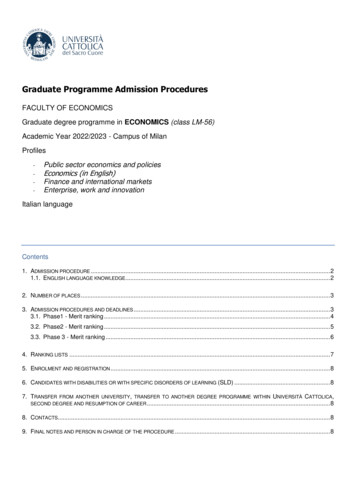
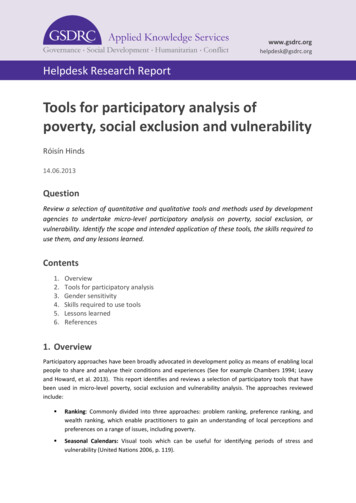
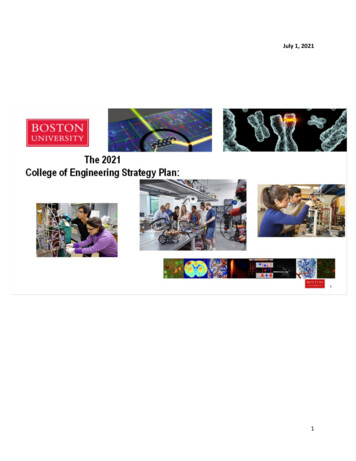
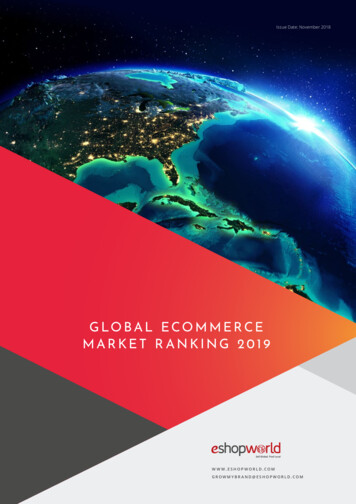
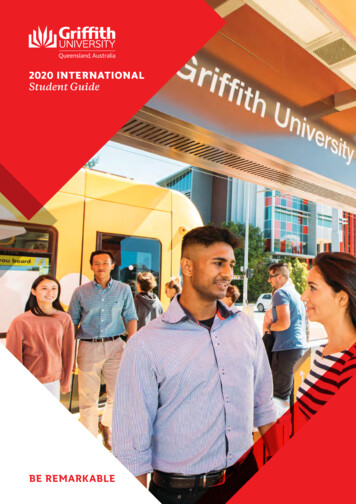
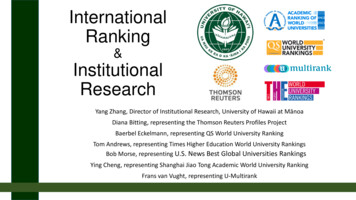
![GLOBAL MASTER IN BUSINESS ADMINISTRATION [GMBA]](/img/9/cat-p-192-i.jpg)
